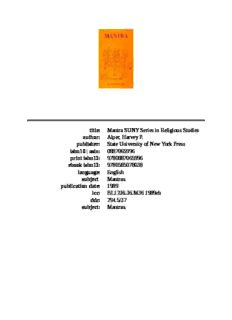
Mantra PDF
Preview Mantra
title: Mantra SUNY Series in Religious Studies author: Alper, Harvey P. publisher: State University of New York Press isbn10 | asin: 0887065996 print isbn13: 9780887065996 ebook isbn13: 9780585078038 language: English subject Mantras. publication date: 1989 lcc: BL1236.36.M36 1989eb ddc: 294.5/37 subject: Mantras. Mantra SUNY Series in Religious Studies Robert Cummings Neville, Editor Mantra Harvey P. Alper, Editor State University of New York Press Published by State University of New York Press, Albany © 1989 State University of New York All rights reserved Printed in the United States of America No part of this book may be used or reproduced in any manner whatsoever without written permission except in the case of brief quotations embodied in critical articles and reviews. For information, address State University of New York Press, State University Plaza, Albany, N.Y., 12246 Library of Congress Cataloging-in-Publication Data Mantra. (SUNY series in religious studies) Bibliography: p. 1. Mantras. I. Alper, Harvey P., 1945- II. Series. BL1236.36.M36 1988 294.5'37 87-6489 ISBN 0-88706-599-6 (pbk.) 10 9 8 7 6 5 4 3 Page v Contents Introduction 1 Harvey P. Alper 1 Mántra kavisasta 15 : Speech as Performative in the Rgveda Ellison Banks Findly 2 Vedic Mantras 48 Frits Staal 3 The Mantra in Vedic and Tantric Ritual 96 Wade T. Wheelock 4 Mantra in Ayurveda*: A Study of the Use of Magico- 123 Religious Speech in Ancient Indian Medicine Kenneth G. Zysk 5 Are Mantras Speech Acts? The Mimamsa* Point of 144 View John Taber 6 The Meaning and Power of Mantras in Bhartrhari's* 165 Vakyapadiya* Harold Coward 7 Mantras in the Sivapurana* 177 Ludo Rocher 8 The Use of Mantra in Yogic Meditation: The Testimony 204 of the Pasupata* Gerhard Oberhammer 9 The Pancaratra* Attitude to Mantra 224 Sanjukta Gupta 10 The Cosmos as Siva's* Language-Game: "Mantra" 249 According to Ksemaraja's* Sivasutravimarsini* Harvey P. Alper Conclusion: MantrasWhat Are They? 295 André Padoux Notes on the Contributors 319 Abbreviations Used in This Volume 322 Bibliographical List 327 Page 1 Introduction An ocean, verily, is the Word. Pancavimsa Brahmana 7.7.9 He lifts the lifewand and the dumb speak. Quoiquoiquoiquoiquoiquoiquoiq "Shem the Penman," Finnegan's Wake This Volume of Essays and bibliography has been assembled in order to focus attention on the Hindu mantra, a common and vital but troubling feature of Indian culture that more often has been taken for granted than made the object of sympathetic and systematic reflection. The volume is exploratory not definitive. It may, I trust, be used as a general introduction to the Hindu mantra and its study, but it does not offer any comprehensive survey, nor does it deal with the use of mantras and mantralike formulas in non-Hindu settings or in those portions of Asia beyond India where Indian culture has penetrated. It is my conviction that the essays collected here speak eloquently for themselves and need no brief content summaries in this Introduction. Rather, I shall set the stage for reading the essays by indicating quite schematically some of the themes and issues in mantric studies that the essays themselves raise. Mantras: Why They Matter and Why They Perples Us In 1984, Sri Satguru Publications in Delhi brought out an English translation of Mahidhara's* Mantramahodadhi, a sixteenth century synthetic treatise on Mantrasastra*. Prior to the book's Introduction the publishers insert a "warning" in which they disclaim responsibilityethically and, I suppose, legallyfor the consequences that ensue when mantras are used unsuccessfully or irresponsibly. If any person on the basis of Yantras as provided in this book commits any nefarious acts which causes loss, etc., to anybody then for his actions the authors/editors/translators, printer and publisher will not be responsible in any way whatsoever. Page 2 The Mantras/Yantras as provided in this book if are tried by anybody and is not crowned by success, which entirely depends on Sadhaka, the author/editors/translators, printer and publisher will not be responsible in any way for such failures. The Mantras/Yantra be practiced and used for the help, good cause and service of Mankind. These should not be used for any nefarious means, the responsibility of such actions will be only that of the Sadhaka. Is this disclaimer meant seriously? Does the publisher fear being sued by someone who believed that he had been harmed by the use of a mantra? Might a disgruntled devotee haul his guru into small claims court because the mantra the latter had imparted did not perform as advertised? Perhaps not, yet this disclaimer underscores the fact that belief in the efficacy of mantras is a commonplace of Indian culture, today as in the past. It further suggests the difficulty of approaching Mantrasastra * from a perspective at once modern and sympathetic. For India, mantras are real, palpable, mental artifacts to be revered and mastered, to be used or misused. While the significance of mantras is not exclusively religious, mantras obviously play a pivotal role in the religious realm. Instead, the history of the religious life of the Indian people might plausibly be read as a history of mantras. To be sure, there must always have been individuals who were sceptical about mantras. The extent of such scepticism in the past is difficult to gauge, but it could not have been great.* The possibility of the successful use of mantras was, and is, simply a common part of the Indian mentality. This centrality of mantras in the common life of the Indian people is indicated, for example, by the observation in the Rajatarangini* that, in twelfth century Kasmir*, the crops in the fields were protected from
